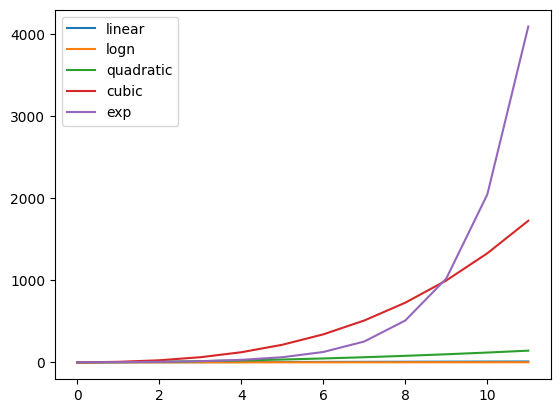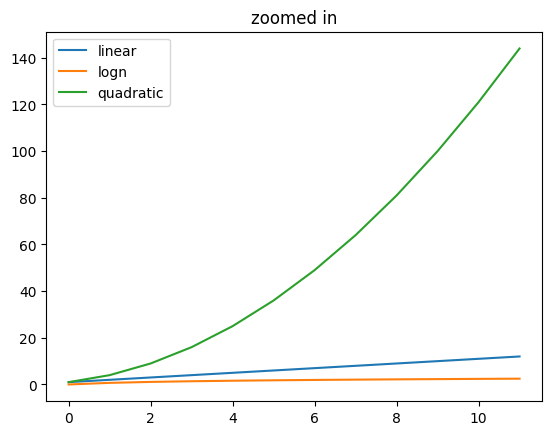Module 2, Practical 3¶
In this practical we will start working with algorithm complexity through practical examples.
Complexity¶
The complexity of an algorithm can be defined as a function mapping the size of the input to the time required to get the result. This is also called the cost function.
There exist several asymptotic (time-measuring) notations. Informally they are:
Big Omega (best case)
Big Theta (average case)
Big O (worst case)
The upper-bound complexity O (the big-Oh) is generally the most interesting to analyze. In this practical we will work with this notation considering several Python code samples.
Big O is a formal notation that describes the behaviour of a function when the argument tends towards the maximum input. Big O takes the upper bound, that is, it considers the worst-case results, the worst execution of the algorithm.
Instead of saying the input is 10 billion, or infinite, we say the input is n size. The exact size of the input doesn’t matter, we only care of how our algorithm performs with the worst input. This approach allows to still work with Big O even if we do not know the exact size of the input during the code execution.
Big O is easy to read once we learn the different order of growth:
[5]:
import math
import pandas as pd
import matplotlib.pyplot as plt
inputList = [1, 2, 3, 4, 5, 6, 7, 8, 9, 10, 11, 12]
linear = [n for n in inputList]
logn = [math.log(n) for n in inputList]
quadratic = [n*n for n in inputList]
cubic = [n*n*n for n in inputList]
exponential = [2**n for n in inputList]
functDict = {'linear': linear, "logn": logn, "quadratic": quadratic, "cubic": cubic, "exp": exponential}
functDf = pd.DataFrame(functDict)
functDf.plot()
plt.show()
plt.close()
functDf[["linear", "logn", "quadratic"]].plot()
plt.title("zoomed in")
plt.show()


Python built-in data structures and relative methods have different time complexity. A comprehensive list is available at this link¶
Example 1
Determine the complexity of these two functions:
[2]:
def printList(inputList):
for item in inputList:
print(item)
printList([4, 5, 6, 8])
print("---------------------")
def printListBothDirections(inputList):
print("Forward:")
for item in inputList:
print(item)
print("Reverse:")
for item in inputList[::-1]:
print(item)
printListBothDirections([4, 5, 6, 8])
4
5
6
8
---------------------
Forward:
4
5
6
8
Reverse:
8
6
5
4
Show/Hide Complexity
Example 2
Determine the complexity of a function that computes the highest value for each pair of values from two input lists l1 and l2.
[3]:
def computeHighest(l1, l2):
for i1 in l1:
for i2 in l2:
if i1 > i2:
print("Value {} in l1 greater than value {} in l2".format(i1, i2))
computeHighest([4, 5, 6, 8], [12,1,42,11])
Value 4 in l1 greater than value 1 in l2
Value 5 in l1 greater than value 1 in l2
Value 6 in l1 greater than value 1 in l2
Value 8 in l1 greater than value 1 in l2
Show/Hide Complexity
Example 3
Determine the complexity of the following functions, performing multiple tasks.
[4]:
def myFunction(items):
for i in reversed(range(1, 5)):
print ("{} seconds left".format(i))
print("boom!\n--------------")
itemsString = ""
for item in items:
itemsString += ">{}".format(item)
print(itemsString[1:])
print("--------------")
pairwiseProducts = []
for item1 in items:
for item2 in items:
if (item1 == item2):
print("I'm in the diagonal {} {}".format(item1, item2))
pairwiseProducts.append(item1*item2)
myFunction([4, 5, 6, 8, 12, 14])
4 seconds left
3 seconds left
2 seconds left
1 seconds left
boom!
--------------
4>5>6>8>12>14
--------------
I'm in the diagonal 4 4
I'm in the diagonal 5 5
I'm in the diagonal 6 6
I'm in the diagonal 8 8
I'm in the diagonal 12 12
I'm in the diagonal 14 14
Show/Hide Complexity
Example 4
Determine the complexity of the listHalver function that returns every division by 2 of the inputList parameter until it’s empty, and the sliceStepper function that uses listHalver function with lists of length n...1.
[5]:
def listHalver(inputList):
sliced = inputList
while len(sliced) >= 2:
sliced = sliced[:int(len(sliced)/2)]
print(sliced)
listHalver([1, 2, 3, 4, 5, 6, 7, 8, 9])
print("------------")
def halverStepper(maxListLength):
for step in reversed(range(1, maxListLength)):
listHalver(list(range(1, step)))
halverStepper(12)
[1, 2, 3, 4]
[1, 2]
[1]
------------
[1, 2, 3, 4, 5]
[1, 2]
[1]
[1, 2, 3, 4]
[1, 2]
[1]
[1, 2, 3, 4]
[1, 2]
[1]
[1, 2, 3]
[1]
[1, 2, 3]
[1]
[1, 2]
[1]
[1, 2]
[1]
[1]
[1]
Show/Hide Complexity
Exercises¶
Let
Mbe a square matrix - a list containingnlists, each of them of sizen. Return the computational complexity of functionfun()with respect ton:
[ ]:
def fun(M):
for row in M:
for element in row:
print(sum([x for x in row if x != element]))
Show/Hide Complexity
Given a list
Lofnelements, please compute the asymptotic computational complexity of the following function, explaining your reasoning.
[ ]:
def my_fun(L):
n = len(L)
tmp = []
for i in range(int(n)):
tmp.insert(0,L[i]-L[int(n/3)])
return sum(tmp)
Show/Hide Complexity
Given a sorted list
alistofnelements, please compute the asymptotic computational complexity of the following function implementing binary search, explaining your reasoning.
[ ]:
def binarySearch(alist, item):
first = 0
last = len(alist)-1
found = False
while first <= last and not found:
midpoint = (first + last)//2
if alist[midpoint] == item:
found = True
else:
if item < alist[midpoint]:
last = midpoint-1
else:
first = midpoint+1
return found
Show/Hide Complexity
Please compute the asymptotic computational complexity of the following code, that computes the Fibonacci sequence according to the following formula:
If
nis even, thenk = n/2andF(n) = [2*F(k-1) + F(k)]*F(k)If
nis odd, thenk = (n + 1)/2andF(n) = F(k)*F(k) + F(k-1)*F(k-1).
[ ]:
# Create an array of length n for memoization (we will see later what memoization is...)
n = 10
f = [0] * n
# Returns n'th fibonacci number using table f[]
def fib(n) :
# Base cases
if (n == 0) :
return 0
if (n == 1 or n == 2) :
f[n] = 1
return (f[n])
# If fib(n) is already computed (thanks to memoization)
if (f[n]):
return f[n]
# Applying above formula [Note value n&1 is 1
# if n is odd, else 0.
if((n & 1)):
# (n & 1) is 1 when n is odd, 0 otherwise
k = (n + 1) // 2
f[n] = (fib(k) * fib(k) + fib(k-1) * fib(k-1))
else :
k = n // 2
f[n] = (2*fib(k-1) + fib(k))*fib(k)
return f[n]
# main code
for i in range(n):
print(fib(i), end=' ') # avoids to add a new line at each iteration
print('') # to go to new line at the end
Show/Hide Complexity
Please compute the asymptotic computational complexity of the function
subsets, that computes all the subsets of a set of elements.
Subsets of {a,b}: {(), ('b',), ('a',), ('b', 'a')}
Subsets of {a,b,c}: {(), ('b',), ('a',), ('c',), ('b', 'a'), ('b', 'c'), ('a', 'c'), ('b', 'a', 'c')}
[ ]:
from itertools import chain, combinations
def subsets(elementSet):
return set(chain.from_iterable(combinations(elementSet, r) for r in range(len(elementSet)+1)))
print('Subsets of {a,b}:', subsets({'a','b'}))
print('Subsets of {a,b,c}:', subsets({'a','b','c'}))
Show/Hide Complexity